N. Pintail/N. Shoveler/A. Wigeon/G. Teal Taking
Do you have any thoughts on this post?
May is American Wetlands Month – a time to celebrate the vital role wetlands play in sustaining fish and wildlife and our hunting and fishing heritage. Wetlands are not just habitats for a wide range of fish and game species, ranging from cutthroat trout to white-tail deer, but they also provide a host of other benefits, including enhancing water quality and storing carbon, which are crucial for our environment’s health. Altogether, the conservation and restoration of wetlands plays a critical role in sustaining fish and wildlife habitat, and in-turn, hunting and fishing opportunities for future generations.
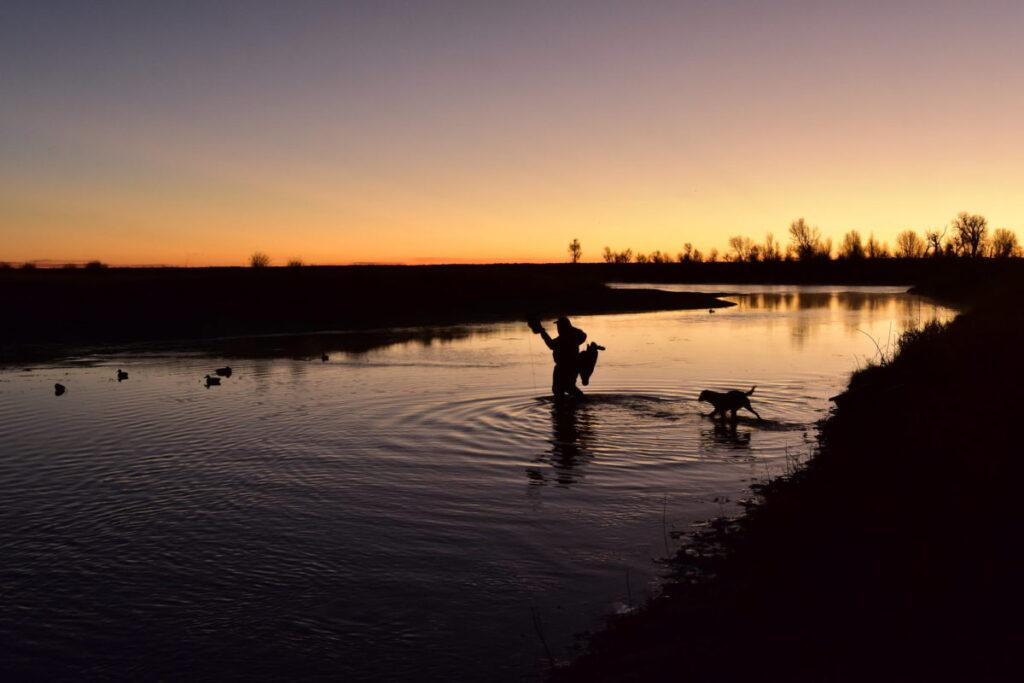
However, while the benefits of healthy wetlands may be clear to hunters and anglers, America’s wetlands are arguably more at risk than ever. The U.S. Fish and Wildlife Service recently released their national 2009-2019 Wetlands Status and Trends report, the sixth in a series of congressionally mandated reports evaluating current wetland health. The report found that net wetland loss increased over the past decade, with vegetated wetlands, like marshes and swamps, being disproportionately impacted. These wetlands are disappearing so quickly that 670,000 acres were lost between 2009 and 2019, an area about equal to the state of Rhode Island. On top of the report, we’re also quickly approaching the one-year anniversary of the U.S. Supreme Court’s decision in Sackett v. EPA, which dealt a significant blow to Clean Water Act protections for wetlands and smaller streams.
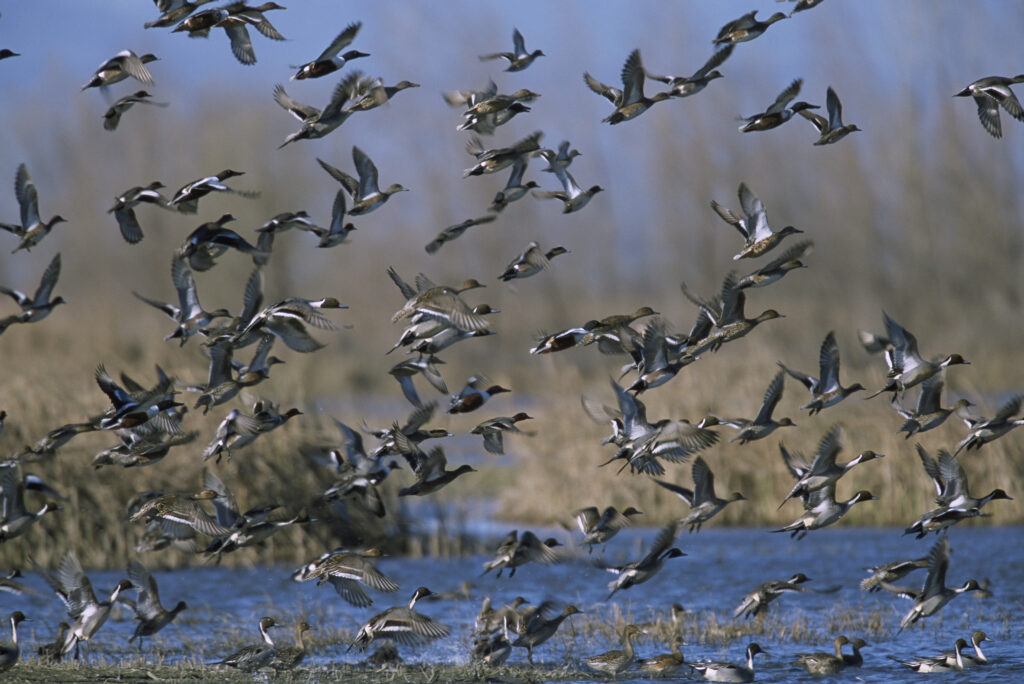
Fortunately, the TRCP and our partners are working together to build support for federal and state policies designed to mitigate the impacts of the Sackett decision and reverse our nation’s decline in wetland habitat and the mounting risk to fish and wildlife, and our hunting and angling traditions. At the federal level, the TRCP, along with Ducks Unlimited and Trout Unlimited, joined the recent America the Beautiful Freshwater Challenge as inaugural members. The new initiative sets new national goals to reconnect, restore, and protect the nation’s wetlands, rivers, and streams and challenges participants to work collaboratively to sustain these important natural resources. The TRCP is also working with the National Association of Wetland Managers and the National Wildlife Federation to build Congressional support for strengthening the Environmental Protection Agency’s Wetland Program Development Grant Program, which provides funding to states and Tribes to develop wetland protection programs and strategies, which is critical at this moment in time. We’re also working to expand the program’s focus to include implementing these wetland protection efforts, which have been identified as a significant need by the state and Tribal wetland community.

At the state level, the TRCP is working with a coalition of groups to pass bipartisan legislation in Colorado that would create a new wetland program to ensure the protection of important wetlands and streams no longer covered by the Clean Water Act. On May 6th, the Colorado General Assembly passed this bipartisan legislation with overwhelming support from the regulated and conservation communities. The bill now heads to Governor Polis’ desk for his signature. The bill, among other things, provides more certainty at the state level regarding protections and permitting for wetlands as the debate of the Clean Water Act’s scope will likely continue. Colorado is now one of the first states in the country to pass legislation to restore protections for wetlands and streams. It can hopefully serve as a model for other states considering similar legislative efforts.
Overall, despite the challenges facing America’s wetlands, hunters and anglers can play a pivotal role in the conservation of these critical resources. As the TRCP and partners continue to work to address these challenges it will be important for hunters and anglers to share their stories with members of Congress, state legislatures, and federal and state agencies on the important roles wetland play in sustaining fish and wildlife and opportunities for hunting and fishing.
Top photo by USFWS/Katrina Mueller
Learn more about TRCP’s commitment to healthy habitat and clean water here.
The TRCP is your resource for all things conservation. In our weekly Roosevelt Report, you’ll receive the latest news on emerging habitat threats, legislation and proposals on the move, public land access solutions we’re spearheading, and opportunities for hunters and anglers to take action. Sign up now.
The bipartisan, bicameral Habitat Connectivity on Working Lands Act would allow USDA to leverage Farm Bill conservation programs to benefit wildlife habitat connectivity and migration corridors in partnership with farmers, ranchers, and landowners.
In the Western U.S., where public lands regularly intermix with privately owned parcels, the ability to extend conservation efforts beyond fence lines is critical to conserving big game migration corridors and wildlife habitat connectivity. To access critical food sources throughout the year, animals like mule deer, antelope, and elk must be able to travel freely across the landscape utilizing historic migration corridors. When these routes lose functionality or habitat, wildlife faces great risks. Expanding voluntary efforts to improve wildlife habitat on private and working lands is crucial to ensuring that the next generation of sportsmen and sportswomen can experience the wonder of the outdoors.
Farm Bill conservation programs can play a pivotal role in corridor conservation, yet for many landowners and agricultural producers, inflexible program policies, bundles of red tape tied to conservation practices, and prohibitive restrictions on farm and ranch operations limit both the appeal and conservation outcomes of these programs.
“The farms and ranches of the West provide much of the essential habitat that wildlife need to survive. Most landowners care deeply about wildlife and yet the costs associated with supporting wildlife can jeopardize their ability to stay in business,” said Lesli Allison, CEO of the Western Landowners Alliance. “As more and more land is developed, the pressure is increasing on the remaining intact private lands to provide food and shelter for many different species. The bipartisan Habitat Connectivity on Working Lands Act ensures ranchers and farmers have access to the full suite of tools and resources to conserve and steward these lands for the benefit of people and wildlife.”
For example, producers enrolling in the Grassland Conservation Reserve Program (GRCP) currently forfeit eligibility to receive cost-share and assistance through the Environmental Quality Incentives Program (EQIP) to address other resource concerns like invasive species, erosion, plant diversity, and wildlife habitat. That is a significant barrier to western farmers and ranchers who look to the Farm Bill for help in their efforts to create and enhance habitat for wildlife, while improving the economic viability of their operation.
Recognizing this, the USDA launched its Migratory Big Game Initiative (MBGI) in 2022 through a partnership with the state of Wyoming. Under the partnership, the USDA tested an innovative application of Farm Bill conservation programs to support farmers and ranchers stewarding key habitat for migratory big game species in Wyoming. Through the partnership, producers in WY are eligible to receive cost-share and technical assistance through EQIP to improve habitat and remove barriers to migrating wildlife in tandem with annual rental payments through GCRP that relieve development and conversion pressure on working lands in priority migration areas in exchange for improved livestock management.
This partnership has proven as successful as it is innovative. In Wyoming, conservation program enrollments in priority corridors jumped 264% compared to pre-partnership levels. Despite that, USDA is unable to expand this model nationwide under the MBGI without a change to the 2018 Farm Bill. That is where the bipartisan Habitat Connectivity on Working Lands Act introduced by Senator Martin Heinrich (D-N.M.) and Representatives Ryan Zinke (R-Mont.) and Gabe Vasquez (D-N.M.) comes in.
“Western ranchers work daily to combat ecological challenges, improve water access, and `conserve millions of acres of healthy habitat for their herds and for native wildlife species. This bipartisan bill makes practical updates to successful, existing conservation programs to maximize the benefits of working lands for our native wildlife,” said Kaitlynn Glover, executive director of the Public Lands Council. “We appreciate Congressman Zinke and Congressman Vasquez’s work to incentivize and leverage ranchers’ investment in wildlife conservation.”
The Habitat Connectivity on Working Lands Act codifies the MBGI model and would allow USDA to leverage the unique benefits GRCP and EQIP together nationwide. It also spurs USDA research on virtual fencing technologies, includes conservation and restoration of wildlife habitat connectivity as a critical conservation area under the Regional Conservation Partnership Program, and provides greater incentives through EQIP for the adoption of conservation practices that conserve or restore wildlife habitat connectivity.
This bill builds on the MBGI program model popular with farmers and ranchers, allowing them to better tailor Farm Bill conservation programs to their operation’s specific needs. And it is good for wildlife, as Farm Bill conservation programs can be more precisely targeted for specific benefits, like improving habitat connectivity.
“Farmers and ranchers have an immense opportunity to help wildlife endure and thrive for future generations,” said Aviva Glaser, senior director for agriculture policy at the National Wildlife Federation. “This common-sense, bipartisan legislation will help farmers, ranchers, and landowners support the wildlife that migrate through their fields, pastures, and forests — and the hunters, anglers, birders, and outdoor recreationists that enjoy them. Congress should include this common sense, no-cost proposal in the 2024 Farm Bill and strengthen U.S. Department of Agriculture voluntary conservation programs.”
TRCP is excited about the Habitat Connectivity on Working Lands Act because it helps complement successful public land corridor conservation efforts with the long track-record of voluntary, incentive-based conservation on private land promoted through the Farm Bill. We appreciate the leadership of Senator Heinrich and Congressmen Zinke and Vasquez in introducing this legislation and hope to see this common-sense bill included in the Farm Bill as a clear win-win for agricultural producers and wildlife.
Working lands provide key habitat for migratory fish and wildlife, including big game like elk and mule deer. USDA’s voluntary conservation programs need to work together to support farmers and ranchers who create and enhance this habitat, and the next Farm Bill is our opportunity to make that happen.” said Becky Humphries, CEO at the Theodore Roosevelt Conservation Partnership. “The Habitat Connectivity on Working Lands Act removes unnecessary barriers to working lands stewardship. The TRCP thanks Senator Heinrich and Congressmen Zinke and Vasquez for their leadership on this bill and urges its inclusion in the Farm Bill.”
Learn more about Farm Bill conservation programs here
Photo: Josh Metten
You can help. Conservation is, and should be, a shared priority regardless of party affiliation or ideology. Congress needs to hear that this is important to you. Take action here.
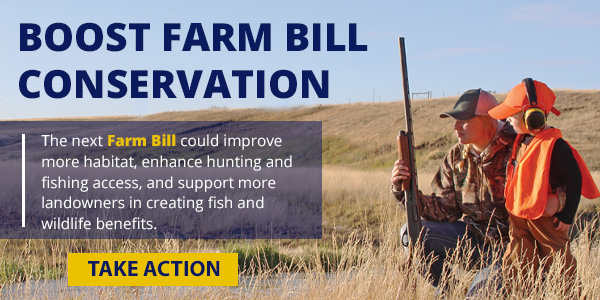
The ACE Reauthorization Act aims to boost funding and provide vital enhancements to conservation programs benefiting fish and wildlife.
The America’s Conservation Enhancement (ACE) Reauthorization Act of 2024 passed the Senate on Wednesday May 8, 2024, by unanimous consent. The ACE Reauthorization Act was sponsored by Senators Tom Carper (D-Del.) and Shelly Moore Capito (R-W.Va.) and would reauthorize multiple programs that benefit hunting and angling including, the National Fish Habitat Partnership, the North American Wetlands Conservation Act, the Chesapeake Bay Program, and the National Fish and Wildlife Foundation. It also helps address threats like chronic wasting disease. This reauthorization provides technical improvements, administrative streamlining, and increased authorized funds to improve these programs.
“The America’s Conservation Enhancement Reauthorization Act will benefit fish and wildlife while enhancing outdoor recreation opportunities for millions of hunters and anglers,” said Becky Humphries, CEO of the Theodore Roosevelt Conservation Partnership, “TRCP applauds the Senate’s passage of this important bipartisan legislation and looks forwards to building on the success of these crucial programs.”
The original ACE Act was passed in 2020 and sponsored by Sen. Tom Carper (D-Del.) and Sen. John Barrasso (R-Wyo.). Many of its authorizations expire next year, necessitating the passage of the ACE Reauthorization act to ensure these programs can continue to operate in good legal standing.
The ACE Act is co-sponsored by Senators Ben Cardin (D-Md.), John Boozman (R-Ark.), Alex Padilla (D-Calif.), Roger Wicker (R-Miss.), Sheldon Whitehouse (D-R.I.), Markwayne Mullin (R-Okla.), Chris Van Hollen (D-Md.), Bill Cassidy (R-La.), Ron Wyden (D-Ore.), Cindy Hyde-Smith (R-Miss.), Lindsey Graham (R-S.C.), Gary Peters (D-Mich.), Angus King (I-ME) and John Barrasso (R-Wyo.).
The legislation is endorsed by the Theodore Roosevelt Conservation Partnership, Ducks Unlimited, the Congressional Sportsmen’s Foundation, the National Wildlife Federation, American Sportfishing Association, the Association of Fish & Wildlife Agencies, Backcountry Hunters and Anglers and the National Audubon Society.
The TRCP looks forward to working with the House of Representatives to ensure this essential legislation for hunters and anglers becomes law.
TRCP works to maintain and strengthen the future of hunting and fishing by uniting and amplifying our partners’ voices in conserving and restoring wildlife populations and their habitat as challenges continue to evolve.
Learn more about TRCP’s commitment to healthy habitat and clean water here.
Photo: Josh Metten
It’s early May in New England and like many anglers that love to target striped bass, I am gearing up and itching to get out on the water. A friend of mine on Cape Cod has been catching stripers for the last week and while I enviously hit the like button on his social media posts, I also worry about what this season will bring for the most popular recreationally targeted saltwater species on the East Coast. If you are also a striped bass angler, you probably know that the stock is in trouble, and the fish need our help.

Currently, striped bass are overfished and the spawning stock biomass – an important indicator of the health of the stock and equal to the combined weight of all females capable of reproducing – is much lower than where it needs to be to have a thriving fishery. While the commercial harvest of striped bass has been slowly decreasing, the recreational harvest took a big jump in 2022, which is partially why the Atlantic States Marine Fisheries Commission, the governing body for striped bass, took emergency action in 2023 to narrow the slot limit for harvest to 28 to 31 inches.
But here’s the rub — since 1990, approximately 90 percent of striped bass that have been caught have been released either voluntarily or due to regulations, so it’s not just direct harvest that is causing declines. Currently, ASMFC estimates that 9 percent of stripers that are released alive don’t make it and eventually die. Just to put this into perspective, of the 29.6 million stripers caught and released by recreational anglers in 2022, an estimated 2.7 million died. This estimate is very rough, and while we still need more science to obtain a more accurate assessment, it’s in line with the estimations used by many other fisheries agencies, which are often in the 10 to 15 percent range.
It’s not all doom and gloom for our beloved stripers, however, and as you head out on the water you have an opportunity to make an immediate difference to help striped bass each time you catch one. There is ample science that shows that the fate of fish after release is primarily determined by how we as anglers chose to catch, handle, and release each fish. The science also shows that subtle changes in angler actions when catching, handling, and releasing fish can reduce mortality. It would take little effort to increase the chance of survival and health for stripers after release, and a reduction in that 9 percent mortality estimate by just 1 percent would save an additional 300,000 stripers to be caught again another day and support recovering stocks.
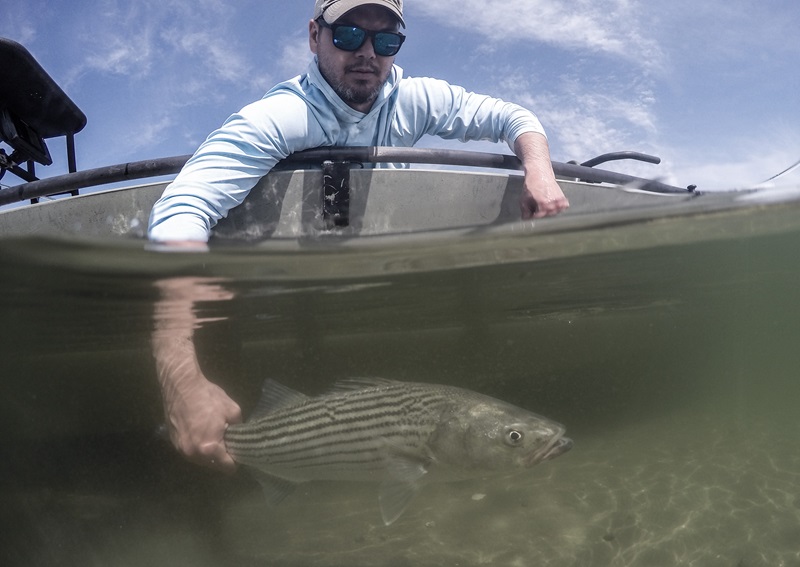
Keep Fish Wet, the organization I run, provides science-based best practices so that you can help create a more resilient striped bass stock. Several years ago, we collaborated with two striper guides (one of whom is also an artist) to create Stripers In Our Hands, an open-source campaign and infographic with step-by-step instructions on how to create the better outcomes for each striped bass that you release. The campaign is centered around our three science-based Principles that are best practices for releasing fish: minimize air exposure, eliminate contact with dry surfaces, and reduce handling time. These three Principles constitute the actions that are most within an angler’s control and that make the most amount of difference to the health and survival of fish after release. They can be used with any type of fishing, so whether you’re fishing from a center console, kayak, or the shore, and throwing bait, plugs, or flies, learning and adopting our three Principles is the swiftest way to put conservation into action.
As more science emerges on how striped bass respond to capture, handling, and release, Stripers In Our Hands will evolve so that anglers trust that a systematic, objective process was used to derive the best practices. We encourage anglers to sign up for our Advocate program – it’s free! – to stay in the pipeline about our science-based Principles and Tips, including information on taking fish-friendly photos.
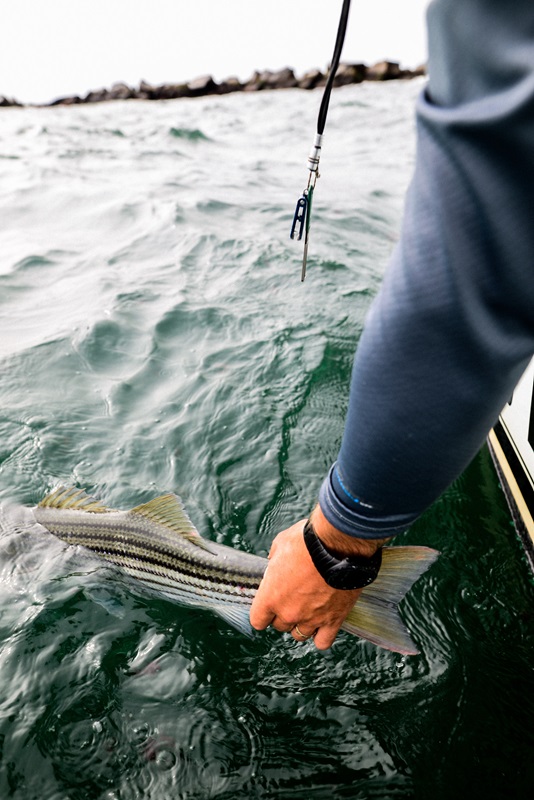
If we want vibrant striped bass stocks for years to come, we all need to do our part and advocate for the fish on and off the water. That means using science-based best practices to take better care of each striped bass intended for release. This will help build resiliency in the striped bass stocks as we continue to work through solutions for other challenges that striped bass are facing, from antiquated policy and management to habitat loss and climate change.
Sascha Clark Danylchuk is the executive director of Keep Fish Wet. She uses her background as a fisheries scientist and passion as a fisher to build a community around helping anglers create better outcomes for each fish they release.

Support TRCP’s forage fish conservation efforts to help protect striped bass.
The TRCP is your no-B.S. resource for all things conservation. In our weekly Roosevelt Report, you’ll receive the latest news on emerging habitat threats, legislation and proposals on the move, public land access solutions we’re spearheading, and opportunities for hunters and anglers to take action. Sign up now.
Theodore Roosevelt’s experiences hunting and fishing certainly fueled his passion for conservation, but it seems that a passion for coffee may have powered his mornings. In fact, Roosevelt’s son once said that his father’s coffee cup was “more in the nature of a bathtub.” TRCP has partnered with Afuera Coffee Co. to bring together his two loves: a strong morning brew and a dedication to conservation. With your purchase, you’ll not only enjoy waking up to the rich aroma of this bolder roast—you’ll be supporting the important work of preserving hunting and fishing opportunities for all.
$4 from each bag is donated to the TRCP, to help continue their efforts of safeguarding critical habitats, productive hunting grounds, and favorite fishing holes for future generations.
Learn More
